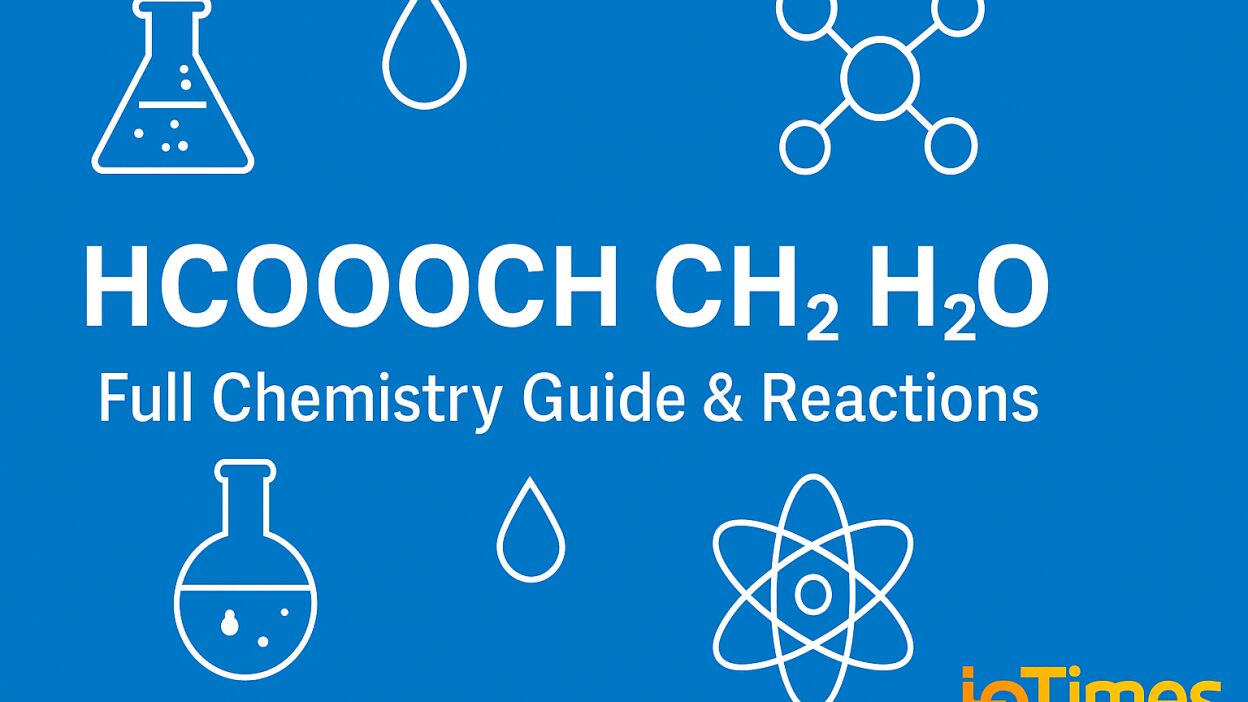In the world of chemistry, even a simple combination of molecular formulas can point to something powerful. One such case is the expression “hcooch ch2 h2o” — a shorthand that may appear cryptic at first but represents the building blocks of essential organic and aqueous reactions. This combination refers to methyl formate (HCOOCH₃), a methylene group (CH₂), and water (H₂O).
If you searched for “hcooch ch2 h2o,” you’re likely trying to understand how these compounds relate to one another — whether in synthesis, hydrolysis, or energy production. This article explains what this combination means in a chemical context, how these molecules interact, and where they matter in both academic and industrial applications.
We’ll walk you through:
-
What each component in hcooch ch2 h2o represents
-
Their individual and combined chemical properties
-
Common reactions and mechanisms involving them
-
Industrial uses, environmental roles, and energy applications
-
Current trends, safety considerations, and research directions
Let’s dive into the chemistry behind this formula and discover why hcooch ch2 h2o is more than just a string of letters — it’s a key to understanding critical organic processes.
What Does “hcooch ch2 h2o” Represent?
Before we explore the chemistry, let’s decode what this keyword most likely refers to in the world of molecular interactions:
Breaking It Down
-
HCOOCH (Methyl Formate): Likely a shorthand for methyl formate, a simple ester derived from formic acid (HCOOH) and methanol (CH₃OH).
-
CH2 (Methylene Group): A divalent functional group found in organic compounds, often reactive and acting as a bridge or intermediate in synthesis.
-
H2O (Water): Universal solvent and reactant in countless chemical reactions.
While “hcooch ch2 h2o” isn’t a standard chemical formula by IUPAC standards, it symbolically points to a reaction pathway or a set of reactants/products involved in esterification or hydrolysis processes.
The Chemistry of Each Component in “hcooch ch2 h2o”
1. Methyl Formate (HCOOCH₃)
Methyl formate is an ester that forms through the reaction of formic acid and methanol:
HCOOH + CH₃OH ⇌ HCOOCH₃ + H₂O
Key Properties:
-
Molar mass: 60.05 g/mol
-
Boiling point: 31.5°C
-
Smell: Fruity, sweet (used in perfumes and flavoring)
-
Uses: Solvent, blowing agent for polyurethane foams, precursor in chemical synthesis
2. Methylene Group (CH₂)
The methylene group is often used as a bridge or intermediate in organic reactions. It is commonly found in alkenes (e.g., CH₂=CH₂) or as part of formaldehyde and other carbon skeletons. It plays a role in chain elongation, alkylation, and even DNA methylation processes.
3. Water (H₂O)
Water is the most universal reactant or product in organic reactions. It plays critical roles in:
-
Hydrolysis reactions
-
Solvent-based mechanisms
-
Reversible reaction environments (equilibrium shifts)
Common Reactions Involving “hcooch ch2 h2o”
The combination of hcooch ch2 h2o often implies one of several important chemical reactions. Here are the most relevant:
1. Esterification
This is the reaction where an acid reacts with an alcohol to form an ester and water — perfectly illustrated by HCOOH + CH₃OH forming HCOOCH₃ (methyl formate) and H₂O.
Reaction:
HCOOH + CH₃OH ⇌ HCOOCH₃ + H₂O
Relevance to “hcooch ch2 h2o”: This expression may describe the outcome of this esterification reaction.
2. Hydrolysis of Esters
This is the reverse of esterification — breaking down esters in the presence of water to yield the original alcohol and acid.
Reaction:
HCOOCH₃ + H₂O → HCOOH + CH₃OH
Industrial Use: This principle is used in the breakdown of biodegradable plastics and esters in metabolism.
3. The Eschweiler–Clarke Reaction
Involving formic acid (part of HCOOCH), formaldehyde (can derive from CH₂), and water:
Reaction:
RNH₂ + HCHO + HCOOH → RN(CH₃)₂ + CO₂ + H₂O
Used to methylate amines — an important step in pharmaceutical synthesis.
Industrial Applications of “hcooch ch2 h2o” Compounds
1. Hydrogen Production
Formic acid-based compounds (like methyl formate) are used as hydrogen carriers. In the presence of catalysts (e.g., Pd/C), these compounds can release H₂ gas, which is vital for:
-
Hydrogen fuel cells
-
Green energy solutions
-
Portable hydrogen sources
2. Polymer and Foam Production
Methyl formate is used in:
-
Blowing agents for polyurethane foam
-
Solvents for resin and coatings
-
Plasticizers in polymer production
3. Fragrance and Flavor Industry
Due to its sweet, rum-like aroma, methyl formate (HCOOCH₃) is used in:
-
Perfumes
-
Food flavorings (artificial rum, raspberry)
Safety and Environmental Considerations
While each compound has specific properties, their combination in reactions can introduce hazards.
Methyl Formate Hazards:
-
Highly flammable
-
Can cause respiratory irritation
-
Requires proper ventilation in lab and industrial settings
Water’s Role:
-
Promotes hydrolysis (which can be desirable or not, depending on process)
-
Enhances reaction reversibility, affecting yield and product stability
Environmental Impact:
-
Formic acid is biodegradable
-
Methyl formate breaks down rapidly in air and is low in toxicity
-
Still, precautions must be taken in industrial discharge management
Recent Research and Trends (2024–2025)
1. Catalytic Decomposition of Formic Acid
Recent studies (2024, ACS Catalysis) are exploring metal-free catalysts for hydrogen production via formic acid — a step toward greener energy.
2. Space Chemistry
Methyl formate has been detected in interstellar clouds, according to a 2023 ESA study — making it a molecule of interest in astrochemistry and origin-of-life research.
3. CO₂ Recycling
Methanol and formic acid are used in carbon capture and utilization (CCU). They help store carbon in chemical form and release energy when needed — a closed-loop for sustainability.
Frequently Asked Questions (FAQ)
What does “hcooch ch2 h2o” mean in chemistry?
It likely refers to methyl formate (hcooch), methylene group (ch2), and water (h2o). This set of molecules often appears in esterification or hydrolysis reactions.
Is hcooch the same as methyl formate?
Yes. HCOOCH₃ is the molecular formula of methyl formate. It forms via the reaction of methanol and formic acid.
How are these compounds used together?
In esterification or decomposition reactions. Together, they play roles in organic synthesis, energy storage (hydrogen release), and even industrial foam production.
Expert Insight
“The combination of compounds like hcooch ch2 h2o isn’t just academic. These molecules are central to real-world innovations in sustainable fuel and green chemistry.”
– Dr. Alan R. Matthews, Organic Chemist, GreenTech Institute
Case Study: Green Hydrogen from Formic Acid
A 2024 pilot project in Germany used methyl formate derivatives to produce hydrogen on-site for buses. This avoided the need for high-pressure hydrogen storage and reduced CO₂ emissions by over 80% compared to traditional fuels.
Read Also: Australian Men’s Cricket Team vs India National Cricket Team Timeline
Conclusion
Understanding hcooch ch2 h2o reveals a fascinating intersection of organic chemistry, industrial utility, and sustainable innovation. Whether you’re interested in ester chemistry, renewable energy, or organic synthesis, this trio of compounds offers insight and opportunity.
By mastering how methyl formate, methylene groups, and water interact, chemists and engineers can build safer, greener, and more efficient chemical processes.
Disclaimer: This article is for educational purposes only. Always consult a qualified professional before using chemical substances in practice.




